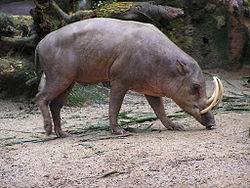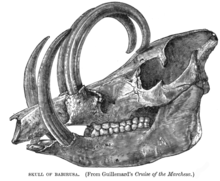North Sulawesi babirusa
| North Sulawesi Babirusa | |
|---|---|
 |
|
| Adult male | |
 |
|
| Scientific classification | |
| Kingdom: | Animalia |
| Phylum: | Chordata |
| Class: | Mammalia |
| Order: | Artiodactyla |
| Family: | Suidae |
| Genus: | Babyrousa |
| Species: | B. celebensis |
| Binomial name | |
|
Babyrousa celebensis Deninger, 1909 |
|
 |
|
The North Sulawesi babirusa, Babyrousa celebensis, is a pig-like animal native to Sulawesi and some nearby islands (Lembeh, Buton, and Muna Islands) in Indonesia. It has two pairs of large tusks composed of enlarged canine teeth. The upper canines penetrate the top of the snout, curving back toward the forehead. The North Sulawesi babirusa is threatened from hunting and deforestation.
The common and scientific names are various transcriptions of its local name, which literally translated means "pig-deer" (from Indonesian babi "pig" + rusa "deer" - see also Javan Rusa) in reference to the huge tusks of the male suggestive of a deer's antlers.
Together with the other members of the genus Babyrousa, the North Sulawesi babirusa has usually been considered a subspecies of a widespread Babyrousa babyrussa, but recent work suggests that there may be several species, differentiable on the basis of geography, body size, amount of body hair, and the shape of the upper canine tooth of the male. Following the split, the "true" Babyrousa babyrussa is restricted to Buru and the Sula Islands.
Most experts agree that babirusas are part of the pig family, and are one of the oldest living members of the family, representing a subfamily, Babyrousinae, that branched off from the warthog branch of the pig family (Subfamily Phacochoerini) during the Oligocene or early Miocene.
...
Wikipedia

